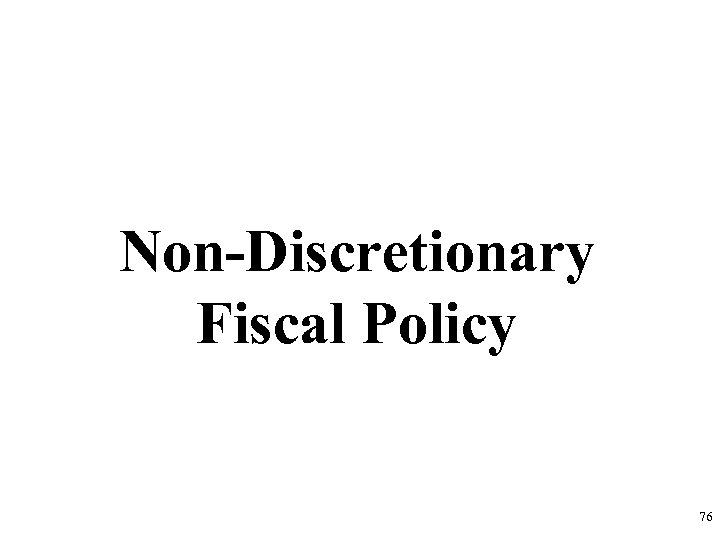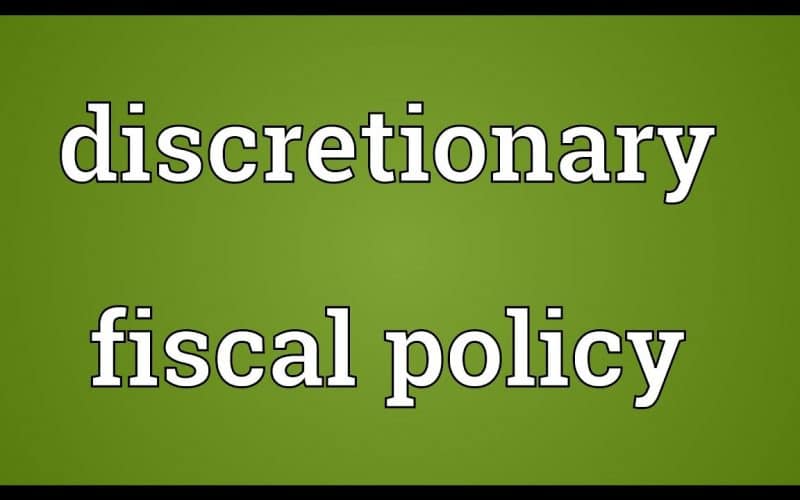In this section, we will briefly discuss the roles of discretionary fiscal policy, non-discretionary fiscal policy, examples, countercyclical discretionary fiscal policy, and automatic stabilizers vs discretionary fiscal policy. let’s quickly enlighten you on the word fiscal policy and all related.
Fiscal Policy is changing the government’s budget to influence aggregate demand. Moreover, it is also when government spending and revenue-raising adjust to affect the macroeconomy, including aggregate demand for goods and services, employment, inflation, and economic growth. Fiscal policy also helps put government and consumer spending under control. The most common kinds are fiscal stimulus, meaning to increase or initiate growth, and countercyclical discretionary fiscal policy.
Subsequently, a contractionary fiscal policy can be used to rein when an economy is in a state whereby growth is getting out of control and therefore causing inflation and asset price bubbles. It will help bring it to a sustainable level. A contractionary discretionary policy will also lower government spending and increase taxation. This policy will shift aggregate demand to the left which automatically denotes a decrease.
A fiscal policy is to be tight or contractionary when revenue is higher than spending (e.g when the government budget is in surplus) and loose or expansionary when spending is higher than revenue (i.e. the budget is in deficit). The focus is not on the level of the deficit, but on the change in the deficit. A reduction in the deficit from $200 billion to $100 billion is to be a contractionary fiscal policy, even though the budget is still in a deficit.
Let’s say the economy has slowed down resulting in lesser spending causing more unemployment. This car needs some fuel to accelerate itself. So the government decides to fuel the economy’s engine by decreasing taxes and increasing government spending.
Discretionary fiscal policy refers to
Discretionary fiscal policy refers to changes in government spending or tax rates. In other words, it is used to expand or slim the economy. For example, when the UK cut VAT in 2009 to provide a boost to spending. However, the output determines by the level of aggregate demand, so a discretionary fiscal policy can be used to increase aggregate demand and thus also increase the output. This measure would help to close the deflationary gap. So, fiscal policy is a demand-side policy that uses government spending and taxation policy to influence aggregate demand.
Discretionary fiscal policy differs from automatic fiscal stabilizers. These automatic stabilizers steps in when there is a recession. A government automatically spends more because the economy forces more people to claim unemployment benefits. However, the government may find these automatic stabilizers to be inadequate to deal with major issues and instabilities in the economy. This will make the government increase public works and spending schemes too.
Discretionary fiscal policy examples
Discretionary fiscal policy examples use two tools, they are the budget process and the tax code. The first tool is the discretionary portion of the U.S. budget. Congress determines this type of spending with appropriations bills each year. The largest is the military budget. All other federal departments are part of discretionary spending too.
The budget process also contains mandatory spending. This includes payments from Social Security, Medicare, Medicaid, and interest payments on the national debt. Congress mandates these programs because they are the law of the land. However, to amend or revoke the relevant law to change these programs Congress must vote. Therefore, making changes in the mandatory budget are very difficult. For this reason, it isn’t a tool of discretionary fiscal policy.
The second tool is the tax code. It includes taxes on workers’ incomes, corporate profits, imports, and other excise fees. Only Congress has the power to change the tax code. Congress changes to the tax code have to be done by approving new laws. The Senate and the house of representatives must pass these laws. But the president has the power to change how tax laws are implemented. He can send directives to the Internal Revenue Service to adjust the enforcement of rules and regulations.
Non Discretionary fiscal policy

The non-discretionary fiscal policy consists of policies that are made into the system so that an expansionary or contractionary stimulus can be given automatically. Unemployment insurance, the progressive income tax, and welfare services as built-in policies.
Non-discretionary fiscal policy and spending is a tale designed to put some spending decisions off-limits. All spending is discretionary, some more than others. The least discretionary is meeting the debt obligations of the US Government. The only thing lacking is the will to confront out-of-control spending, and to spend within the resources of the Federal government. Never said it would be easy, playing Santa clause and giving out free stuff using people hard earn money.
Non-discretionary fiscal policy refers to various ongoing programs of government spending and taxation. These are primarily for income maintenance purposes. They include social security, welfare, and unemployment compensation.
But in many economies, there are taxes that are structured in such a way that they automatically raise more revenue during booms and less during recessions. Progressive income taxes, for example, or stamp duties on real-estate sales, or payroll taxes. And in many economies, there are government expenditure programs that automatically expend more money during recessions and less during booms, such as unemployment “insurance”, welfare benefits for the unemployed, etc. Those have a counter-cyclical fiscal effect even when no one in government decides to do anything. Non-discretionary fiscal policy is a fiscal policy outcome that does not depend on the discretion of anyone.
Read Also: Discretionary Investment Management: Overview, Advantages, and Risk
Countercyclical Discretionary fiscal policy
The countercyclical discretionary fiscal policy calls for, the fiscal entity (usually a central bank system). Often when the economy takes a downturn the government counteracts with lower interest rates, relaxed capital requirements, and deficit budgeting. While often spending heavily on public works contracts, and reduced taxation. The idea of this is that when the economy recovers then interest rates should rise again, capital requirements re-instated, budgets returned to surplus, and taxation should be increased to pay back the incurred debts.
The wealthy elites use persuasion to convince unaware and easily misled voters that the second half of the formula does not need to be implemented. This second part is the hard one. Consequently, presents huge government debts in developed nations and an inability to handle the next inevitable economic downturn.
Countercyclical discretionary fiscal policy is when expenditure is cut down and taxations increase during booms/bubbles. It is also an increase in expenditure. When taxation cuts during recessions, with the aim of reducing the volume of the business cycle. Moreover, this will help avoid severe recessions and sustained depressions.
Automatic stabilizers vs Discretionary fiscal policy
Automatic stabilizers play a key role in providing income insurance for households and consequently stabilizing demand and output. The automatic action of tax-transfer policies was accompanied in most countries by discretionary action in the field of tax, social, and labor market policy. This action included a broad range of measures such as tax cuts, employment incentives, activation policies, higher benefits, and increased transfers to low-income households. Therefore, especially for the recent crisis, it is important to assess the contribution of automatic stabilizers to the overall fiscal expansion and to compare their magnitudes across countries. Understanding the relationship between automatic stabilizers vs discretionary fiscal policy is crucial because countries with larger automatic stabilizers have to rely less on discretionary fiscal stimulus packages, other things being equal.
The discretionary policy is a macroeconomic policy based on the judgment of policymakers at the moment as opposed to the policy set by predetermined rules. Examples may include passing a new spending bill that promotes a certain cause, such as green technology, or the creation of a federal jobs program.
Key Differences
The key difference between the automatic stabilizers vs discretionary fiscal policy is the timing of implementation. When the economy begins to go through an economic fluctuation, automatic stabilizers immediately respond without any official or government body having to take action. With discretionary policy, there is a significant time fallback. Before action can be taken, Congress must first identify that there is an issue and that action needs to be taken. Then Congress needs to design and implement a policy response. Then the law needs to be passed and the relevant agencies need to adjust and alter any necessary procedures so they can carry out the law. It is due to this significant fallback that economists like Friedman believe that discretionary fiscal policy could be destabilizing.
On the other hand, there are limits on automatic stabilizers as they focus on managing the aggregate demand of a country. Discretionary policies can target other, specific areas of the economy. Discretionary policies can address failings of the economy that do not strictly bind to aggregate demand. For example, if an economy is going through a recession because its workers lack a certain set of skills. It is impossible for an automatic stabilizer to address that problem. But government programs, such as retraining, can address this problem.
Finally, automatic stabilizers, such as the tax code and social service agencies, exist prior to an economic fluctuation. They create discretionary policies to respond to a fluctuation and only come into existence once a fluctuation starts to occur.
Of course, it is not possible to create an automatic stabilizer for every potential economic issue, so discretionary policy allows policymakers flexibility.
Conclusion
During cyclical movements, fiscal policy can play an important role in order to help stabilize the economy. But discretionary policy usually implies implementation struggles and is not automatically set aside when economic conditions change.
Frequently Asked Questions
A shift in government spending or taxes is referred to as discretionary fiscal policy. Its goal is to expand or contract the economy as necessary.
There are two sorts of discretionary fiscal policy options available to the government: expansionary and contractionary. Each sort of fiscal policy is employed to stop or delay recessions and booms at different stages of the economic cycle.
What is discretionary and non discretionary fiscal policy?
A discretionary fiscal policy is one that is formed as a result of planned adjustments in government expenditure, taxation, or both. Non-discretionary fiscal policy, on the other hand, is a fiscal policy that stems from the government’s intention to spend and change taxes.
What is non discretionary fiscal policy example?
Nondiscretionary fiscal policy refers to a number of current government spending and taxing programs. Nondiscretionary fiscal policy is exemplified by the payment of unemployment benefits. When the number of unemployed people rises, as it does during a recession, the compensation must rise as well.
- Discretionary Investment Management: Overview, Advantages and Risk
- PUBLIC FINANCIAL MANAGEMENT: ALL YOU SHOULD KNOW (+DETAILED GUIDE)
- BAD CREDIT: Definitions, Examples & Penalties
- RABBI TRUST: All you need to know, Explained!!
- POULTRY BUSINESS: Beginners’ Guide to Launch a Lucrative Poultry Business
- General Aggregate Limit: Definition and Insurance Policies
- Fiscal Agent: Best Practices & Detailed 2021 Guide
- WHAT FACTORS AFFECT THE PRICE OF BITCOIN?






